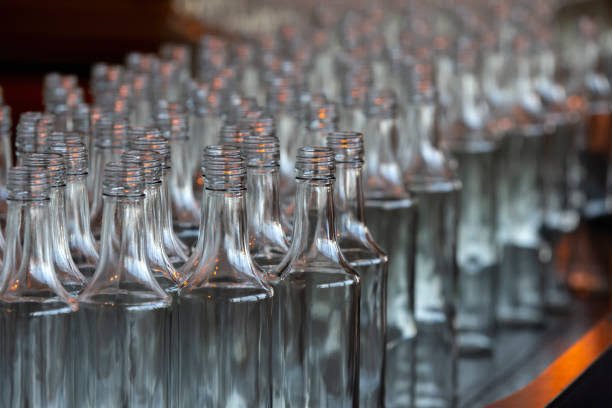Introduction
The scientific and technological revolution in all fields has brought about tremendous changes in glass science and glassmaking technology. Glass and its layers are used for thermal, electrical insulation. New materials open up great prospects, such as glass fibers, in which glass fibers and glass layers are combined with various binding organic substances. Structures such as boats, ships, and car bodies are made of glass fibers.
Glass bottles are a common household item that we often take for granted. From holding our favorite beverages to preserving food items, serving as vessels for liquids ranging from water to exquisite wines, glass bottles play an essential role in our lives., Let’s delve into the fascinating world of glass bottle production, exploring the history, significance, and intricate Glass Bottle Manufacturing Process behind these versatile containers.
History of Glass Bottle Production
Glassmaking dates back to ancient civilizations like the Egyptians and Mesopotamians, who crafted glass vessels by hand.The industrial revolution brought about mechanized glass production techniques, revolutionizing the bottling industry. Today, modern technology has refined the process, making glass bottles a staple in the packaging landscape.
Importance of Glass Bottles in the Packaging Industry
- Glass bottles are preferred for their purity, preserving the flavor and quality of bottled contents.
- They are eco-friendly, recyclable, and sustainable, making them a popular choice for environmentally-conscious consumers.
- The versatility of glass allows for innovative designs, catering to diverse packaging needs.
Overview of the Manufacturing Process
Glass bottle production involves a meticulous process that combines raw materials, heat, and craftsmanship. Let’s explore each step in detail.
Raw Materials
Sand: The Foundation of Glass
Silica sand, the primary ingredient, provides the structure and clarity of glass. Sand is sourced from quarries and undergoes purification to remove impurities before being mixed with other materials.
Additives and Colorants: Enhancing Glass Properties
Chemical additives like soda ash and limestone are mixed with sand to modify the glass’s properties. Colorants such as iron oxide or selenium dioxide give glass bottles their distinct hues.
Cullet: Recycling Glass for Sustainability
Cullet, recycled glass, is crushed and melted along with the raw materials to reduce energy consumption. Recycling glass bottles minimizes waste and conserves natural resources, promoting a circular economy.
Melting and Forming
Batch Mixing: Combining Raw Materials
Raw materials are carefully measured and mixed in specific proportions to create the glass batch. The batch is fed into a furnace where it undergoes a heating process to melt into a viscous liquid.
Furnace Operations: Heating and Melting Glass
The furnace operates at high temperatures above 1500°C to melt the glass batch. Continuous melting and homogenization ensure a consistent molten glass composition for forming.
Forming Processes: Blowing, Pressing, and Molding
Glass bottles are formed using various techniques such as blowing, pressing, or molding. Each method shapes the molten glass into the desired bottle design before it cools and solidifies.
Quality Control
Inspecting Raw Materials for Purity
Raw materials undergo rigorous quality checks to ensure purity and uniformity. Any impurities can affect the glass properties and compromise the bottle’s integrity.
Monitoring Temperature and Composition
Advanced sensors and monitors regulate the furnace temperature and glass composition. Optimal control ensures the glass remains within specified parameters for quality production.
Testing Strength and Durability
Finished glass bottles undergo strength tests like impact resistance and pressure testing. Quality control measures guarantee that bottles meet industry standards for safety and durability.
Finishing and Packaging
Annealing: Cooling and Strengthening Glass
Glass bottles are annealed, slowly cooled to relieve internal stresses and enhance durability. The annealing process improves the glass’s strength and resistance to thermal shock.
Cutting, Decorating, and Labeling
Glass bottles are cut to precise dimensions, decorated with labels, and customized with designs. Decorative techniques like frosting, painting, or embossing add aesthetic appeal to the finished bottles.
Distribution In Market
Once bottles are inspected and labeled, they are packaged for distribution. Glass bottles are shipped to various industries, from beverage companies to cosmetics brands, for filling and retail. RUISEN GLASS BOTTLE SUPPLIER provides high quality glass bottles in various designs with their 25 years of production experience.
Recap of Glass Bottle Manufacturing Process
From raw materials to forming, quality control to finishing, the production of glass bottles is a complex and precise operation. Each step contributes to creating high-quality bottles that cater to diverse packaging needs.
Importance of Quality Control in Production
Maintaining strict quality control protocols ensures that glass bottles meet industry standards for purity, strength, and durability.Quality assurance is essential for upholding consumer trust and brand reputation.
Future Trends in Glass Bottle Industry
As sustainability and eco-consciousness continue to drive consumer preferences, glass bottle manufacturers are exploring innovative recycling and green production practices.
Technological advancements and design innovations are shaping the future of glass packaging, offering customizable and sustainable solutions.
In conclusion, the art of making glass bottles involves a harmonious blend of tradition, technology, and craftsmanship. From ancient origins to modern-day advancements, glass bottles remain a timeless and essential packaging solution for various industries.



